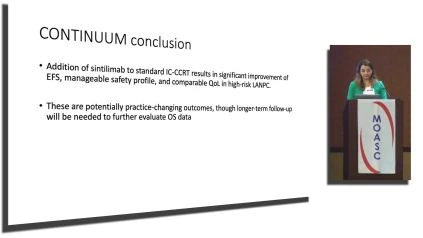Presented By: Shirin Attarian, MD
Date Aug 12, 2023
In the realm of oncology, Head and Neck Cancer stands as a significant challenge, both in terms of its prevalence and the intricacies surrounding its diagnosis and treatment. This complex and diverse set of malignancies affects millions across the globe each year, making it the seventh most common cancer worldwide. Amid the countless battles against this formidable adversary, the insights of medical professionals like Dr. Shirin Attarian have proven invaluable.
Dr. Attarian’s meticulous review of Head and Neck Cancer reveals a landscape of statistics that underscore the urgency of continued research and innovative approaches. The staggering fact that over 1.1 million new cases are diagnosed annually casts a somber light on the breadth of its impact. In the United States alone, the annual incidence of oral and pharyngeal cancers surpasses 54,000, with a grim consequence of over 11,000 deaths each year. These stark numbers weave a narrative of lives affected, families disrupted, and the medical community’s unyielding dedication to providing solutions.
Gender disparities further emphasize the complexity of this disease, with males being disproportionately affected, with a ratio ranging from 2 to 4 males for every female diagnosed. However, this gender skewing is only one facet of a multifaceted issue. The socioeconomical patterns and regional variations that Dr. Attarian’s review uncovers delve into the intricate interplay of factors contributing to the prevalence and severity of Head and Neck Cancer. The socio-economic risk observed here eludes simple explanations, as it transcends the boundaries imposed by tobacco and alcohol usage, two traditionally attributed risk factors. It becomes evident that the disease’s regional variations stem from the prevalence of these risk factors, opening doors to further investigations into the intricate relationship between environment and genetics in shaping cancer’s trajectory.
As we peer into the future, the role of infectious agents like HPV and EBV further illuminates the complexities at play. A steady rise in HPV-related cancers, particularly in the oropharynx, adds layers of urgency to the quest for effective interventions. The advent of the HPV vaccine, extending its recommended usage to age 26, holds promise for curtailing this trend. However, the optional nature of the vaccine for adults aged 27-45 sparks debates about its effectiveness and its potential impact on reducing the incidence of oropharyngeal cancer in older age groups. With the looming specter of a projected 30% annual increase in Head and Neck Cancer incidences by 2030, the urgency to marshal all available tools to combat this rise is palpable. While incidence and mortality rates continue their upward trajectory, the relative stagnancy of survival rates underscores the critical need for innovative strategies.
Enter the realm of clinical trials and breakthrough treatments, as Dr. Attarian navigates the landscape of the Jupiter-02 trial, the CONTINUUM trial, the FRAIL IMMUNE trial, and the DEPEND trial. These studies reveal a tantalizing glimpse into the future of cancer treatment, where the synergy of immunotherapy and tailored interventions emerges as a beacon of hope. The outcomes of the Jupiter-02 trial offer a lifeline to patients with recurrent or metastatic NPC, with the combination of toripalimab, gemcitabine, and cisplatin demonstrating a statistically significant improvement in overall survival, ultimately reshaping the standard of care.
Continuing the exploration, the CONTINUUM trial introduces the transformative role of immunotherapy in locally advanced nasopharyngeal carcinoma. Sintilimab’s impact on distant metastasis-free survival and locoregional recurrence-free survival paints a picture of hope for those grappling with the advanced stages of this cancer. As the medical community grapples with questions of efficacy, safety, and long-term impact, the journey toward integrating these findings into clinical practice becomes a voyage of great importance.
The FRAIL IMMUNE trial steps into the realm of cisplatin-ineligible patients, revealing the potential of durvalumab, weekly carboplatin, and paclitaxel as a formidable first-line option. As patients face the challenges of recurrent metastatic HNSCC, the trial’s findings underscore the significance of this combination, offering an average OS of 18 months, a testament to the power of innovative treatments.
The DEPEND trial echoes a similar sentiment, weaving the promise of nivolumab-based neoadjuvant chemoimmunotherapy into the fabric of locally advanced HPV-negative HNSCC treatment. This novel approach presents deep responses and an optimistic outlook on survival and locoregional control. The pivotal role of response-adapted therapy redefines our understanding of treatment customization and its implications for patient outcomes.
As we distill these findings, the take-home message resonates clearly. The role of immunotherapy stands as a cornerstone in the treatment of Head and Neck Cancer, bridging the chasm between tradition and innovation. From metastatic settings to locally advanced scenarios, the integration of immunotherapeutic agents like PD1 inhibitors reshapes the contours of possibility, providing patients with new avenues for hope. The careful orchestration of these treatments, however, necessitates a nuanced approach, taking into account patient characteristics, disease stage, and potential challenges posed by tolerance and toxicity.
Looking forward, Dr. Attarian’s work lays the groundwork for the evolution of oncology care. The future beckons toward HPV-related cancer prevention, personalized treatments tailored to biomarker-based insights, and the exploration of novel agents. The resonance of her findings is not confined to the walls of medical institutions but extends into the realm of public health and healthcare equity. As we navigate the path ahead, the critical need to address healthcare disparities and ensure equitable access to these cutting-edge treatments remains an imperative.
In sum, Dr. Shirin Attarian’s exploration of Head and Neck Cancer transcends the confines of clinical research, touching the lives of patients, practitioners, and policymakers alike. This comprehensive review stands as a testament to the unwavering dedication of medical professionals in the quest to conquer cancer, illuminating the path toward a future where hope conquers adversity, and innovation triumphs over the challenges that Head and Neck Cancer presents.

